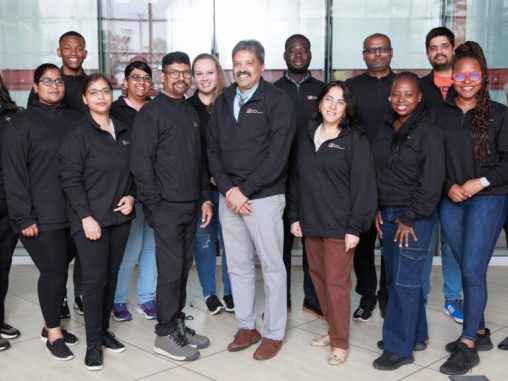
- 205 AIME (Alabama Institute for Manufacturing Excellence)
- Phone (205) 348-2363
- Faculty Website
Dr. M. N. V. Ravi Kumar
Distinguished University Research Professor, Adjunct Faculty
Contact
- 205 AIME (Alabama Institute for Manufacturing Excellence)
- phone (205) 348-2363
- Faculty Website
Education
PhD, Drug Delivery, Indian Institute of Technology, Roorkee, 2000MSc, Applied Chemistry, Devi Ahilya Vishwavidyalaya, India, 1996BSc, Physical Sciences, Nagarjuna University, India, 1992
Pioneering research performed by the Kumar-lab has led to the development of non-competitive active targeting carrier systems and its application to human health and diseases. Kumar-lab reported a novel strategy to engineer double-headed nanosystems by the chemical modification of the carboxyl terminal polyester with a linker that offers tripodal arrangement of ligands on the particle surfaces, which traditionally allows coupling of only one ligand per polymer chain (Chem. Comm. 2019). Kumar-lab employed this technology in the treatment of intraocular inflammation in a canine model (Science Advances 2020). To optimize ligand-receptor stoichiometry and to enable better targeting, very recently, the Kumar-lab reported a two-step synthesis of a novel ABA triblock copolymer of lactic acid (A block) and ethylene glycol (B block) that has periodic side chains with 6-16 free carboxylic groups for ligand conjugation (J. Am. Chem. Soc. 2017). This discovery has allowed the opening of a new avenue for lupus, a disease that represents a major medical challenge (Science Advances 2020; Highlighted in Nature Reviews Rheumatology). This work on the next generation of nanosystems has advanced fundamental understanding of blood-GUT and other biological barriers and has led to the development several patents, issued, or pending. The Kumar-lab has adopted a mixed theoretical (modeling) and experimental approach to his work and has tackled difficult and crucial subjects such as identification of ligand binding site on the receptor (ACS Appl. Bio Mater. 2019), dual drug loaded particles for combinations therapies (Nanotechnology 2010).
Affiliated Areas
Chemical and Biological Engineering
Selected Publications
- R. Ganugula, M. Arora, S. Dwivedi, D. S. Chandrashekar, S. Varambally, E. M. Scott, and M. N. V. Ravi Kumar. Systemic anti-inflammatory therapy aided by double-headed nanoparticles combined with injectable long-acting insulin in a rodent model of diabetes eye disease. ACS Nano 17: 6857-6874, 2023. [Equal Contribution]
- R. Ganugula, N. K. Nuthalapati, S. Dwivedi, D. Zou, M. Arora, R. Friend, D. Sheikh-Hamad, R. Basu, M. N. V. Ravi Kumar. Nanocurcumin combined with insulin alleviates diabetic kidney disease through P38/P53 signaling axis. J. Control. Release 353: 621-633, 2023 [Equal Contribution]
- S. Dwivedi, A. Gottipati, R. Ganugula, M. Arora, R. Friend, R. Osburne, A. Rodrigues-Hoffman, R. Basu, H.-L. Pan, and M. N. V. Ravi Kumar. Oral nano-curcumin alone or in combination with insulin alleviates diabetic neuropathy in rats. Mol. Pharm. 19: 4612-4624, 2022 [Equal Contribution] [Cover article]
- D. Zou, M. Arora, R. Ganugula, M. Kumar, E. M. Scott, D. Shah, M. N. V. Ravi Kumar. Nanoparticles that do not compete with endogenous ligands–molecular characterization in vitro, acute safety in canine, and interspecies pharmacokinetics modeling to humans. J. Control. Release 332: 64-73, 2021 [Equal Contribution; Co-corresponding authors]
- R. Ganugula, M. Arora, D. Zou, S. K. Agarwal, C. Mohan, M. N. V. Ravi Kumar. A highly potent lymphatic system-targeting nanoparticle-cyclosporine prevents glomerulonephritis in mouse model of lupus. Sci. Adv. 6: eabb3900, 2020. [Equal Contribution] Highlighted in Nat Rev Rheumatol 16, 410 (2020). https://doi.org/10.1038/s41584-020-0462-9.
Awards and Honors
- AIMBE College of Fellows 2023 inductee, American Institute for Medical and Biological Engineering, June 2023
- 2023 Elected a Corresponding Fellow, Royal Society of Edinburgh (FRSE).
- 2023 Elected a Fellow, American Institute for Medical and Biological Engineering (AIMBE).
- 2022 Elected a Foreign Member, The French National Academy of Pharmacy.
- 2021 Humboldt Research Prize.
Dr. Kumar's Impact

Igniting Innovation: 5 Inventions that Started at UA
May is National Inventors’ Month. To celebrate, we took a moment to applaud innovation at The University of Alabama, which is designated one of the Top 100 U.S. Universities in 2024 by...

UA Professor at the Cutting-Edge of Medicine Design
Dr. M.N.V. Ravi Kumar, Distinguished University Research Professor with The University of Alabama College of Community Health Sciences, is a world-renowned voice in the field of translational science for medicine...

UA to Honor 8 Faculty for Research, Creativity
Eight faculty members will be recognized with the President’s Faculty Research Award.